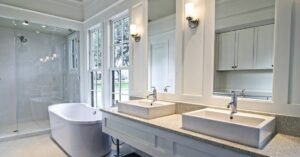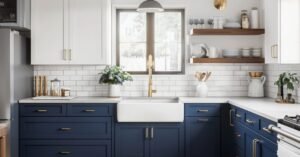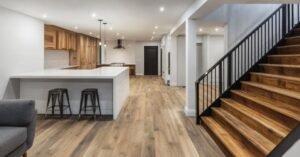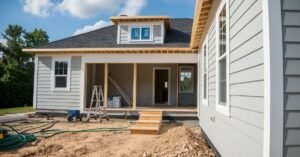A kitchen remodel is an exciting investment, but without a solid plan, it can quickly become a financial nightmare. Labor costs, materials, and hidden surprises all add up, leaving many homeowners shocked by their final bill.
So, how do you get the kitchen of your dreams without draining your savings? Whether you’re considering a minor update or a luxury remodel, understanding where to spend and where to save is key to achieving the perfect balance of style and affordability.
Average Cost of a Kitchen Remodel in Naperville, IL
The cost of a kitchen remodel in Naperville varies based on the level of renovation.
A minor remodel focuses on cosmetic upgrades, while mid-range projects involve slight structural changes, upgrades to flooring and countertops, and new appliances. High-end remodels include luxury materials, major structural changes, and custom work.
Below are typical price ranges:
- Minor Remodel: $10,000–$25,000
- Mid-Range Remodel: $25,000–$50,000
- High-End Remodel: $50,000+
Factors That Influence the Cost
Understanding what drives the cost of a kitchen remodel is essential for setting a realistic budget and avoiding unexpected expenses.
Careful planning helps prioritize upgrades, balance costs, and prevent overspending. Knowing where your budget will have the most impact ensures a remodel aligning with your vision and financial expectations.
Complexity of the Remodel
Simple updates, such as painting and new fixtures, are more affordable than projects requiring demolition, layout modifications, or structural reinforcements.
Expanding a kitchen or removing walls requires additional labor and materials. Custom work, such as built-in storage or intricate backsplashes, also increases expenses. The more involved the project is, the higher the cost will be due to extended timelines and specialized labor.
Kitchen Size and Layout Changes
A larger kitchen requires more materials and labor for flooring, cabinetry, and countertops. Changing the layout adds expenses, especially if it involves moving plumbing, gas lines, or electrical wiring.
Expanding the kitchen footprint may require structural changes, such as wall removal or reinforcement, which will increase costs. Keeping the existing layout while upgrading materials is a more budget-friendly approach.
Flooring and Countertop Replacement
The choice of materials affects both durability and cost. Laminate and vinyl flooring are budget-friendly choices, while hardwood and natural stone cost more. Countertops follow a similar pattern—laminate is affordable, while quartz, granite, and marble are premium options.
Installation costs vary based on material weight, labor intensity, and whether old surfaces need removal. Custom-cut stone or intricate designs require skilled craftsmanship and will increase expenses.
Cabinetry
Cabinets are a major cost component. Stock cabinets are the most affordable, while semi-custom options allow for moderate personalization. Custom cabinets are the most expensive due to specialized labor and high-quality materials.
Features such as soft-close hinges, pull-out shelves, and custom finishes increase costs. Refacing existing cabinets is a lower-cost alternative to full replacement.
Plumbing and Wiring Upgrades
Upgrading plumbing or electrical systems adds costs due to labor and materials. Relocating appliances such as sinks and dishwashers requires new plumbing lines. Outdated wiring may need replacement to support modern appliances and lighting.
If walls or floors must be opened to access pipes and wires, repair and refinishing costs add to the total. Gas line adjustments for cooktops or ovens require licensed professionals, further increasing expenses.
Appliances
Higher-end appliances come with premium features, energy efficiency, longer lifespans, and higher price tags. Built-in or panel-ready models cost more due to customization.
Smart appliances with advanced technology add costs, as do oversized or specialty appliances that need custom cabinetry or ventilation adjustments. Installation and disposal of old units also contribute to expenses.
Kitchen Islands
Adding or upgrading a kitchen island affects both materials and labor. Prefabricated islands are more affordable, while custom-built designs with storage, sinks, or cooktops cost more.
Larger islands require additional countertop material, cabinetry, and possibly plumbing or electrical work. High-end features like waterfall countertops or integrated appliances further increase the final price.
Custom Work
Custom-built elements, such as cabinets, pantries, or range hoods, require skilled labor and specialized materials. Intricate tile backsplashes, handcrafted woodwork, or unique design elements elevate the kitchen’s aesthetics but come at a premium.
Customization also extends to built-in seating, pull-out storage solutions, and tailored lighting designs, all of which require additional time and expertise.
Lighting Upgrades
Lighting affects both function and aesthetics. Recessed lights, under-cabinet lighting, and pendant fixtures enhance visibility but require electrical work. Smart lighting systems with dimmable or color-changing features increase costs.
Custom fixtures or designer brands add expenses, as do installations requiring rewiring or ceiling modifications.
Painting
Painting is one of the most cost-effective upgrades, but quality matters. High-end paints with washable finishes last longer but cost more. Labor expenses depend on surface preparation, such as patching holes or removing old wallpaper.
Painting cabinets requires specialized techniques like spray finishes or hand-brushed detailing, adding to labor costs. Accent walls, textured finishes, or multi-color schemes further increase expenses.
Labor Costs
Skilled professionals, such as electricians, plumbers, and carpenters, charge based on expertise and project complexity. General contractors oversee the remodel, coordinating subcontractors and ensuring compliance with local codes.
Hiring specialists for tile work, cabinetry, or stone countertops adds labor costs. Demolition, debris removal, and post-installation cleanup also require labor, contributing to the final bill.
Unexpected Expenses
Hidden issues, such as water damage, mold, or outdated wiring, can emerge during demolition. Permits, inspections, and code compliance adjustments add unforeseen costs.
Price fluctuations in materials and supply chain delays may require budget flexibility. Setting aside a contingency fund—typically 10–20% of the total budget—helps cover unexpected expenses without derailing the project.
How To Save Money on a Kitchen Remodel
A kitchen remodel is going to cost some money—there’s no getting around that. However, strategic planning can help reduce costs without sacrificing quality or functionality.
Focusing on cost-effective solutions, choosing materials wisely, and knowing where to splurge versus where to save can make a significant difference. Below are practical ways to maximize your budget while achieving a stylish and efficient kitchen.
- Keep the Existing Layout: Avoid moving plumbing, gas lines, and electrical wiring, as these changes add labor and permit costs.
- Refinish or Reface Cabinets: Instead of replacing cabinets, give them a fresh look by repainting, refacing, or swapping out hardware.
- Choose Cost-Effective Countertops: Laminate, butcher block, or quartz alternatives offer durability and style without the expense of granite or marble.
- Shop Smart for Appliances: Look for energy-efficient models on sale, floor models, or rebates to cut costs. Consider slightly older models with similar features.
- Use Stock or Semi-Custom Cabinets: Custom cabinetry is expensive. Stock or semi-custom options provide quality storage at a fraction of the cost.
- DIY Where Possible: Tasks like painting walls, installing backsplash tiles, or assembling cabinets can reduce labor costs if done correctly.
- Hire a Reputable Contractor: Choosing an experienced contractor prevents costly mistakes, delays, and rework that can drive up expenses.
- Time Your Remodel Wisely: Off-season renovations may come with discounts on materials and contractor fees.
- Repurpose or Sell Old Materials: Selling old cabinets, appliances, or fixtures can offset new costs, and repurposing existing materials saves money.
- Compare Material Costs: Visit multiple suppliers to find the best deals on flooring, lighting, and finishes without compromising quality.
- Plan for Hidden Costs: Set aside 10–20% of your budget for unexpected expenses to avoid financial strain mid-project.
Common Kitchen Remodel Mistakes To Avoid
A kitchen remodel is a major investment, and mistakes can lead to unnecessary expenses, delays, and regrets. Poor planning, overspending in the wrong areas, or overlooking essential details can impact both functionality and long-term satisfaction.
Below are the most frequent mistakes to avoid.
- Not Setting a Realistic Budget: Failing to account for all costs, including labor, permits, and unexpected expenses, can lead to overspending or unfinished work.
- Ignoring Workflow and Layout: A poorly designed layout disrupts efficiency. The “kitchen work triangle” (sink, stove, refrigerator) should be functional and accessible.
- Overlooking Storage Needs: Not including enough cabinets, drawers, or pantry space can lead to cluttered countertops and reduced efficiency.
- Choosing Style Over Functionality: Trendy designs may look great but can be impractical. Prioritize durability, ease of use, and long-term appeal.
- Skimping on Quality Materials: Opting for the cheapest materials may save money upfront but can lead to frequent repairs and replacements.
- Attempting Complex Tasks Yourself: Electrical, plumbing, and gas work should be left to professionals to ensure safety and compliance with building codes.
- Not Hiring the Right Contractor: Choosing an inexperienced or unlicensed contractor can result in poor craftsmanship and costly rework.
- Forgetting About Lighting: Insufficient lighting affects both aesthetics and functionality. A mix of task, ambient, and accent lighting is essential.
- Overspending on Unnecessary Features: High-end appliances, luxury finishes, or custom details should align with your budget and long-term needs.
- Not Planning for Ventilation: Poor ventilation can lead to lingering odors and moisture issues. A proper range hood or exhaust fan is essential.
- Rushing the Project: Cutting corners or skipping detailed planning often leads to costly mistakes and unsatisfactory results.
Budget Wisely for a Kitchen Remodel in Naperville
A well-planned budget is the foundation of a successful kitchen remodel. Without clear financial guidelines, costs can quickly spiral, leading to compromises or unfinished work.
Setting realistic expectations from the start—factoring in materials, labor, and hidden expenses—helps you make informed decisions without unnecessary financial strain.
By balancing aesthetics, functionality, and affordability, you can achieve a stunning, high-quality remodel that enhances your home’s value and daily living without financial regret.
Frequently Asked Questions
What is a reasonable budget for a kitchen remodel?
A reasonable budget depends on the scope of work. A minor remodel in Naperville may cost $10,000–$25,000, while a mid-range remodel runs $25,000–$50,000. High-end renovations can easily exceed $50,000. Setting a clear budget and prioritizing upgrades helps manage costs effectively.
What is the most expensive part of a kitchen remodel?
Cabinetry is often the most expensive part, typically making up 30–40% of the budget. Custom cabinets cost more than stock options. Other high-cost items include countertops, appliances, and labor. Structural changes like moving walls or plumbing also significantly impact the total cost.
Do I need a permit for a kitchen remodel?
Yes, permits are required for major remodels involving electrical, plumbing, gas lines, or structural changes. Minor cosmetic updates may not need permits. It’s best to check with Naperville’s building department to ensure compliance with local codes and avoid delays or fines.
How long does a minor kitchen remodel take?
Depending on the scope of the project, a minor kitchen remodel typically takes 4–8 weeks, and a full kitchen renovation can take as long as 6–12 weeks. Factors such as material availability, contractor schedules, and permit approvals can extend the process.




